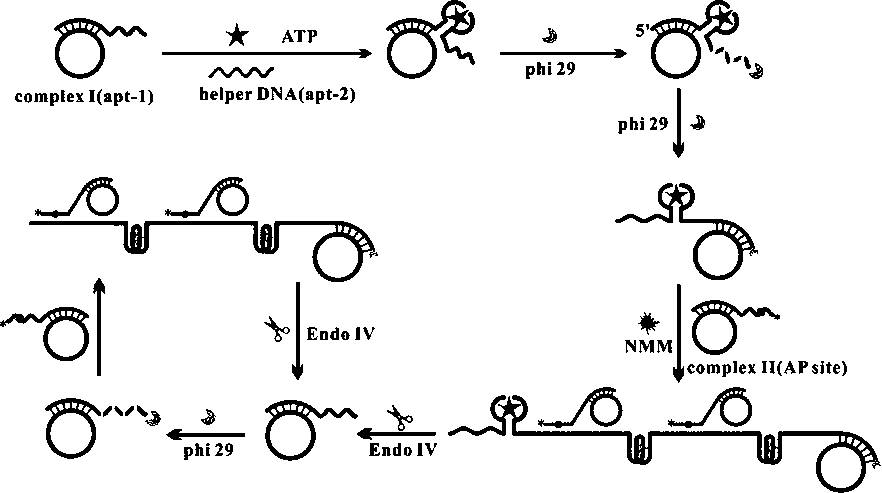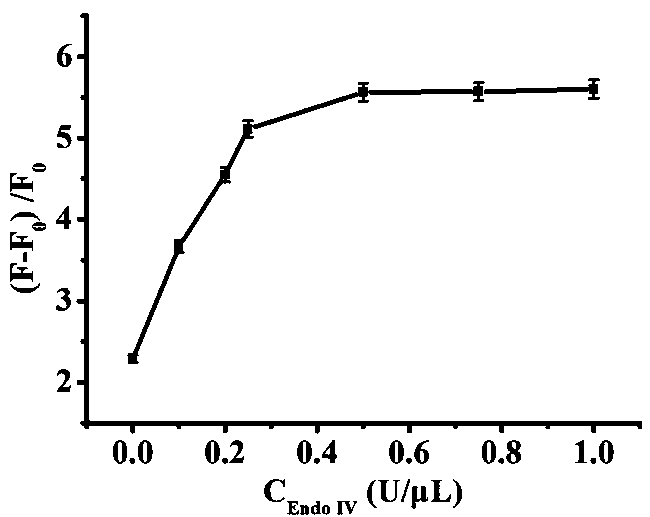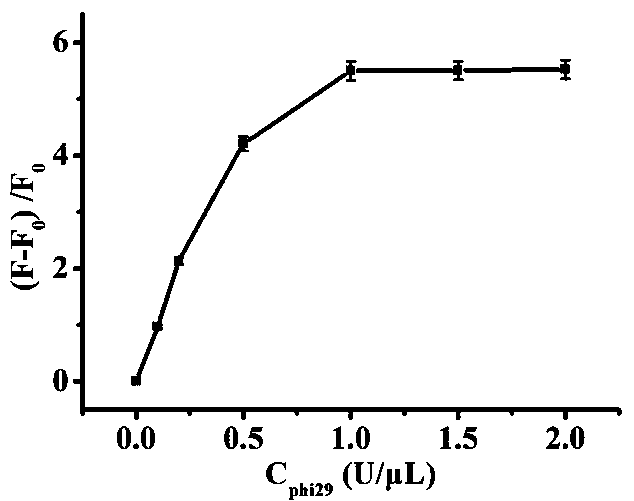Fluorescent biosensor for detecting triphosadenine and preparation method thereof
A biosensor, adenosine triphosphate technology, applied in the direction of fluorescence/phosphorescence, instruments, measuring devices, etc., can solve the problems of long detection cycle, low specificity and sensitivity, etc., and achieve the effect of short detection cycle, easy operation and reduced complexity
- Summary
- Abstract
- Description
- Claims
- Application Information
AI Technical Summary
Problems solved by technology
Method used
Image
Examples
Embodiment 1
[0056] Example 1 Preparation of Circular Template and Composite Probe
[0057] Prepared with 50 mM Tris-HCl, 10 mM MgCl 2 , T4 DNA Ligase Reaction Buffer with 10 mM DTT and 1 mM ATP. Formulated with 10 mM Na 2 HPO 4 , 10 mM NaH 2 PO 4 , 140 mM NaCl, 1 mM KCl, 1 mM MgCl 2 , 1mM CaCl 2 , PBS buffer solution of pH=7.4.
[0058] (1) Mix 42 μL sterile water, 6 μL linear template (10 μM), 6 μL ligation probe (10 μM) and 6 μL 10× T4 DNA ligase buffer, denature at 95°C for 5 min, then Slowly cool down to room temperature to complete the hybridization, then add 3 μL of T4 DNA ligase (60 U / μL) to the reaction system, and react at 16°C for 20 hours; after that, the reaction system is placed in a water bath at 65°C for 15 minutes , inactivate the T4 DNA ligase in the system.
[0059] (2) Add 3 μL of exonuclease Ⅰ (20 U / μL) and 3 μL of exonuclease Ⅲ (100 U / μL) to the above reaction system and react at 37°C for 2 h; then put the reaction system at 85°C Heated in a water bath for 1...
Embodiment 2
[0062] A method for preparing a fluorescent biosensor of the present invention, comprising the following steps:
[0063] (1) Mix 2 μL composite probe I (1 μM), 2 μL dNTP (1 mM), 2 μL composite probe II (1 μM), 2 μL Apt-2 (1 μM), 2 μL phi29 DNA polymerase (1 U / μL), 2 μL endonuclease IV (concentrations are 0.1 U / μL, 0.2U / μL, 0.25 U / μL, 0.5 U / μL, 0.75 U / μL, 1 U / μL), 2 μL NMM (2.4 μM) in 2 μL buffer (50 mMTris-HCl, 10 mM MgCl 2 , 10 mM (NH 4 ) 2 SO 4 , 4 mM DTT, pH 7.5) after mixing, add ATP (100 nM) respectively, mix and react at a constant temperature of 37°C for 90 min;
[0064] (3) Dilute the solution obtained in step (2) with water to 100 μL, and then perform fluorescence detection; the excitation wavelength is set to 486 nm, the emission wavelength is 610 nm, and the detection range is 560 nm-640 nm, and the fluorescence signal changes are read.
[0065] See the test results figure 2 , it can be seen from the figure that as the amount of endonuclease IV increases, the...
Embodiment 3
[0069] A method for preparing a fluorescent biosensor of the present invention, comprising the following steps:
[0070] (1) Mix 2 μL composite probe I (1 μM), 2 μL dNTP (1 mM), 2 μL composite probe II (1 μM), 2 μL Apt-2 (1 μM), 2 μL phi29 DNA polymerase (0.1 U / μL, 0.2 U / μL, 0.25 U / μL, 0.5 U / μL, 1 U / μL, 1.5 U / μL, 2 U / μL), 2 μL endonuclease IV (0.5 U / μL μL), 2 μL NMM (2.4 μM) in 2 μL buffer (50 mM Tris-HCl, 10 mM MgCl 2 , 10 mM (NH 4 ) 2 SO 4 , 4 mM DTT, pH 7.5) after mixing, add ATP (100 nM) respectively, mix and react at a constant temperature of 37°C for 90 min;
[0071] (3) Dilute the solution obtained in step (2) with water to 100 μL, and then perform fluorescence detection; the excitation wavelength is set to 486 nm, the emission wavelength is 610 nm, and the detection range is 560 nm-640 nm, and the fluorescence signal changes are read.
[0072] See the test results image 3 , it can be seen from the figure that as the amount of phi29 DNA polymerase increases, the ...
PUM
 Login to View More
Login to View More Abstract
Description
Claims
Application Information
 Login to View More
Login to View More - R&D
- Intellectual Property
- Life Sciences
- Materials
- Tech Scout
- Unparalleled Data Quality
- Higher Quality Content
- 60% Fewer Hallucinations
Browse by: Latest US Patents, China's latest patents, Technical Efficacy Thesaurus, Application Domain, Technology Topic, Popular Technical Reports.
© 2025 PatSnap. All rights reserved.Legal|Privacy policy|Modern Slavery Act Transparency Statement|Sitemap|About US| Contact US: help@patsnap.com



